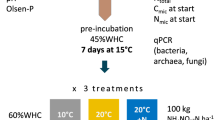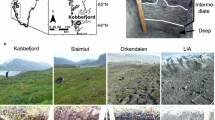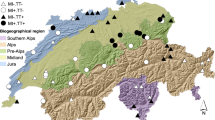Abstract
The temperature sensitivity of soil organic matter (SOM) decomposition is a source of uncertainty in models of soil-climate feedbacks. However, empirical studies have given contradictory results concerning the temperature response of SOM fractions, even as the understanding of the chemical nature of SOM is evolving. The carbon-quality temperature (CQT) hypothesis states that more ‘recalcitrant’ SOM should have higher temperature sensitivity. Incubation studies have often shown a negative correlation between soil respiration rates and temperature sensitivity. However, there have been important exceptions to these results which challenge the assumption that older SOM is necessarily more chemically complex. We asked whether we would expect a universal relationship between temperature sensitivity and soil respiration given that SOM decomposition is influenced by factors other than chemical complexity. We examined temperature sensitivity in long-term incubations of four soils representing two biomes and two ecosystem-level manipulations. Soils from a manipulative climate experiment in Pacific Northwest grasslands demonstrated an increase in temperature sensitivity with incubation duration, but soil from a 20-year input manipulation study in a Northeastern forest showed no relationship of temperature sensitivity with either carbon depletion or incubation time. Furthermore, across all four soils, the temperature sensitivity of soil respiration was frequently inconsistent with indices of carbon quality and did not show a negative correlation with soil respiration rate. We conclude that the CQT hypothesis fails to universally capture the temperature sensitivity of SOM decomposition across environmental contexts, consistent with an emerging understanding of the multiplicity of factors that control soil carbon cycling.


Similar content being viewed by others
References
Bosatta E, Ågren GI (1999) Soil organic matter quality interpreted thermodynamically. Soil Biol Biochem 31:1889–1891. doi:10.1016/S0038-0717(99)00105-4
Bowden R, Rullo G, Stevens G, Steudler P (2000) Soil fluxes of carbon dioxide, nitrous oxide, and methane at a productive temperate deciduous forest
Bowden RD, Deem L, Plante AF et al (2014) Litter input controls on soil carbon in a temperate deciduous forest. Soil Sci Soc Am J 78:S66–S75. doi:10.2136/sssaj2013.09.0413nafsc
Coleman K, Jenkinson DS (1996) RothC - 26.3 - A model for the turnover of carbon in soil, model description and windows user guide. In: Powlson DS, Smith P, Smith JU (eds) Evaluation of soil organic matter models using existing, long-term datasets. NATO ASI S. Springer, Berlin, pp 237–246
Conant RT, Drijber RA, Haddix ML et al (2008) Sensitivity of organic matter decomposition to warming varies with its quality. Glob Chang Biol 14:868–877. doi:10.1111/j.1365-2486.2008.01541.x
Conant RT, Ryan MG, Ågren GI et al (2011) Temperature and soil organic matter decomposition rates—synthesis of current knowledge and a way forward. Glob Chang Biol 17:3392–3404. doi:10.1111/j.1365-2486.2011.02496.x
Craine JM, Fierer N, McLauchlan KK (2010) Widespread coupling between the rate and temperature sensitivity of organic matter decay. Nat Geosci 3:854–857. doi:10.1038/ngeo1009
Crawford County Soil Survey (1979) USDA Soil Conservation Service. Washington, D.C.
Curiel Yuste J, Baldocchi DD, Gershenson A et al (2007) Microbial soil respiration and its dependency on carbon inputs, soil temperature and moisture. Glob Chang Biol 13:2018–2035. doi:10.1111/j.1365-2486.2007.01415.x
Davidson E, Janssens I (2006) Temperature sensitivity of soil carbon decomposition and feedbacks to climate change. Nature 440:165–173. doi:10.1038/nature04514
Fang C, Smith P, Moncrieff J, Smith J (2005) Similar response of labile and resistant soil organic matter pools to changes in temperature. Nature. doi:10.1130/G20750
Fierer N, Schimel JP (2003) A proposed mechanism for the pulse in carbon dioxide production commonly observed following the rapid rewetting of a dry soil. Soil Sci Soc Am J 67:798. doi:10.2136/sssaj2003.0798
Friedlingstein P, Cox P, Betts R et al (2006) Climate-carbon cycle feedback analysis: results from the C4MIP model intercomparison. J Clim 19:3337–3353
Haddix ML, Plante AF, Conant RT et al (2011) The role of soil characteristics on temperature sensitivity of soil organic matter. Soil Sci Soc Am J 75:56–68. doi:10.2136/sssaj2010.0118
Hartley IP, Ineson P (2008) Substrate quality and the temperature sensitivity of soil organic matter decomposition. Soil Biol Biochem 40:1567–1574. doi:10.1016/j.soilbio.2008.01.007
Karhu K, Fritze H, Tuomi M et al (2010) Temperature sensitivity of organic matter decomposition in two boreal forest soil profiles. Soil Biol Biochem 42:72–82. doi:10.1016/j.soilbio.2009.10.002
Kimball B, Conley MM, Wang S et al (2008) Infrared heater arrays for warming ecosystem field plots. Glob Chang Biol 14:309–320. doi:10.1111/j.1365-2486.2007.01486.x
Kleber M (2010) What is recalcitrant soil organic matter? Environ Chem 7:320–332. doi:10.1071/EN10006
Kleber M, Johnson M (2010) Advances in understanding the molecular structure of soil organic matter: implications for interactions in the environment. Adv Agron 106:77–141
Koch O, Tscherko D, Kandeler E (2007) Temperature sensitivity of microbial respiration, nitrogen mineralization, and potential soil enzyme activities in organic alpine soils. Global Biogeochem Cycles 21:1–11. doi:10.1029/2007GB002983
Lefèvre R, Barré P, Moyano FE et al (2014) Higher temperature sensitivity for stable than for labile soil organic carbon–evidence from incubations of long-term bare fallow soils. Glob Chang Biol 20:633–640. doi:10.1111/gcb.12402
Lehmann J, Solomon D, Kinyangi J et al (2008) Spatial complexity of soil organic matter forms at nanometre scales. Nat Geosci 1:238–242. doi:10.1038/ngeo155
Leifeld J, Fuhrer J (2005) The temperature response of CO2 production from bulk soils and soil fractions is related to soil organic matter quality. Biogeochemistry 75:433–453. doi:10.1007/s10533-005-2237-4
Lloyd J, Taylor JA (1994) On the temperature dependence of soil respiration. Funct Ecol 8:315–323
Mikan CJ, Schimel JP, Doyle AP (2002) Temperature controls of microbial respiration in arctic tundra soils above and below freezing. Soil Biol Biochem 34:1785–1795. doi:10.1016/S0038-0717(02)00168-2
Parton WJ, Schimel DS, Cole CV, Ojima DS (1987) Analysis of factors controlling soil organic matter levels in great plains grasslands. Soil Sci Soc Am J 51:1173–1179
Pfeifer-Meister L, Bridgham SD, Little CJ et al (2013) Pushing the limit: experimental evidence of climate effects on plant range distributions. Ecology 94:2131–2137
Plante AF, Conant RT, Carlson J et al (2010) Decomposition temperature sensitivity of isolated soil organic matter fractions. Soil Biol Biochem 42:1991–1996. doi:10.1016/j.soilbio.2010.07.022
Reichstein M, Subke J, Angeli AC, Tenhunen JD (2005) Does the temperature sensitivity of decomposition of soil organic matter depend upon water content, soil horizon, or incubation time? Glob Chang Biol 11:1754–1767. doi:10.1111/j.1365-2486.2005.01010.x
Reynolds LL, Johnson BR, Pfeifer-Meister L, Bridgham SD (2015) Soil respiration response to climate change in Pacific Northwest prairies is mediated by a regional Mediterranean climate gradient. Glob Chang Biol 21:487–500. doi:10.1111/gcb.12732
Schmidt MWI, Torn MS, Abiven S et al (2011) Persistence of soil organic matter as an ecosystem property. Nature 478:49–56. doi:10.1038/nature10386
Sierra CA (2011) Temperature sensitivity of organic matter decomposition in the Arrhenius equation: some theoretical considerations. Biogeochemistry 108:1–15. doi:10.1007/s10533-011-9596-9
Tang J, Riley WJ (2015) Weaker soil carbon—climate feedbacks resulting from microbial and abiotic interactions. Nature 5:1–5. doi:10.1038/NCLIMATE2438
von Lützow M, Kögel-Knabner I (2009) Temperature sensitivity of soil organic matter decomposition-what do we know? Biol Fertil Soils 46:1–15. doi:10.1007/s00374-009-0413-8
Wagai R, Kishimoto-Mo AW, Yonemura S et al (2013) Linking temperature sensitivity of soil organic matter decomposition to its molecular structure, accessibility, and microbial physiology. Glob Chang Biol 19:1114–1125. doi:10.1111/gcb.12112
Zhou T, Shi P, Hui D, Luo Y (2009) Global pattern of temperature sensitivity of soil heterotrophic respiration (Q10) and its implications for carbon-climate feedback. J Geophys Res 114:1–9. doi:10.1029/2008JG000850
Acknowledgments
We thank The Nature Conservancy (TNC), Center for Natural Lands Management (CNLM), and the Siskiyou Field Institute for site use for HOPS. Laurel Pfeifer-Meister, Timothy Tomaszewski, Maya Goklany, Hannah Wilson, Jess Suter, and Chelsea Little and numerous undergraduate volunteers assisted with site set-up, maintenance, and measurements. This research was partially supported by the U.S. Department of Energy, Office of Science, Office of Biological and Environmental Research under award number DE-FG02-09ER604719 and the National Science Foundation MacroSystems Biology Program under award number EF-1340847. We thank Allegheny College for support of the Bousson Experimental Forest, and Sam Reese and numerous Allegheny students for field and laboratory assistance. The views and opinions of authors expressed herein do not necessarily state or reflect those of the U.S. Government or any agency thereof.
Author information
Authors and Affiliations
Corresponding author
Ethics declarations
Conflicts of interest
The authors report no conflicts of interest.
Additional information
Responsible Editor: Stuart Grandy.
Electronic supplementary material
Below is the link to the electronic supplementary material.
Rights and permissions
About this article
Cite this article
Reynolds, L.L., Lajtha, K., Bowden, R.D. et al. The carbon quality-temperature hypothesis does not consistently predict temperature sensitivity of soil organic matter mineralization in soils from two manipulative ecosystem experiments. Biogeochemistry 136, 249–260 (2017). https://doi.org/10.1007/s10533-017-0384-z
Received:
Accepted:
Published:
Issue Date:
DOI: https://doi.org/10.1007/s10533-017-0384-z




